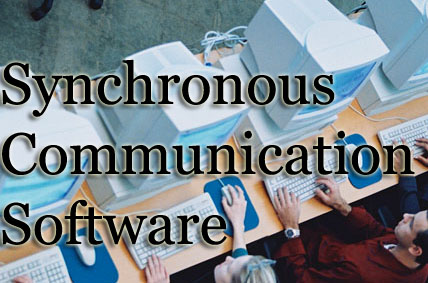 |
ETAP 529 Introduction to Distance Learning Technology Group 4: Abigail Moskovits, Tom Cutonilli, Anne Canale Stalnecker |
|---|---|
| Table of Contents > Introduction > SCS Technologies > Appropriate Uses & Limitations >Support & Costs> References | |
Introduction
The distance learning initiative has just as many partners as the traditional face-to-face learning style. It is what is done during the ‘meeting’ time that affects the quality of learning that takes place.According to Sherry in Issues in Distance Learning, distance learning is ". . . the separation of teacher and learner in space and/or time…the volitional control of learning by the student rather than the distant instructor . . . and noncontiguous communication between student and teacher, mediated by print or some form of technology" (Sherry, 1996).
Distance learning has undergone many permutations during its career. It began as a print-based method of learning, underwent a phase where material was transmitted via television, and has reached its prime today with interactive technologies. Different regions throughout the world engage in different forms of distance education. What affects which mode of learning is implemented in different parts of the world are resources available, audience interested in learning, and philosophies of the instructors (Sherry, 1996).
Sherry explains, "Successful distance education systems involve interactivity between teacher and students, between students and the learning environment, and among students themselves, as well as active learning in the classroom." Synchronous software tools can provide this interactivity in real-time, personalizing the experience. Sherry further explains that interactivity "represents the connectivity the students feel with the distance teacher, the local teachers, aides and facilitators, and their peers" (Sherry, 1996).
Instant messaging, chat and video-conferencing tools provide new opportunities for interactivity in the online environment, enhancing the connectivity for teacher and student, and building and strengthening the community of learning that is so critical to effective distance learning. According to Garrison, "without interactivity and additional methods of two-way communication . . . distance learning degenerates into the old correspondence course model of independent study" (Garrison, 1990). Garrison believes that successful, interactive distance learning only takes place when there is two-way communication between teacher and student.
Next page > Top of Page > Table of Contents
Technology Group 4: Abigail Moskovits, Tom Cutonilli, Anne Canale Stalnecker
ETAP 529 Introduction to Distance Learning
Professor Virginia Yonkers
University at Albany
Spring 2008
Updated 29-Feb-2008